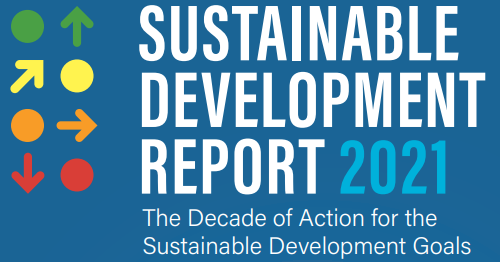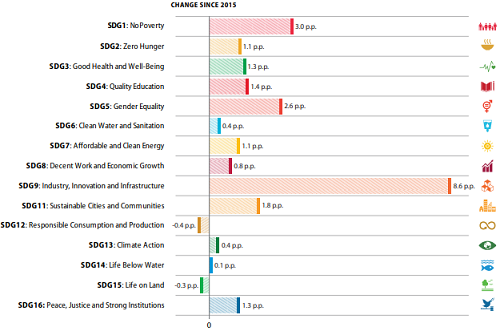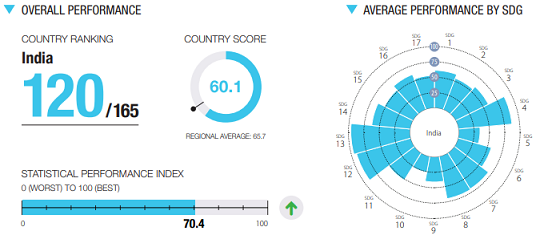The annual Sustainable Development Report for 2021 was released on June 14, 2021, and for the first time since the Heads of State of all 193 UN member countries agreed on the universal Sustainable Development Goals (SDGs) at a historic summit in 2015, the report shows reversal progress.
The report was written by a group of authors led by Prof. Jeffrey Sachs, President of the Sustainable Development Solutions Network (SDSN), and tracks the progress on the Global Goals for 2030.
For 2021, the report has been named “Sustainable Development Report 2021: The Decade of Action for the Sustainable Development Goals.” With just a decade left and the ongoing pandemic, the countries need to adopt various refined measures to achieve their global goals.
Apart from SDR, various other important reports are released by multiple International and National Organisations. These constitute an important part of the UPSC Syllabus. Aspirants looking forward to applying for the upcoming civil services exam can get a comprehensive List of Reports Published by International Organisations at the linked article.
Sustainable Development Report 2021 [UPSC Notes]:-Download PDF Here
In this article, we shall further discuss the key findings of the Sustainable Development Report, along with India’s rank and status in achieving the global goals of 2030. IAS Exam aspirants can also refer to the links below and complement their preparation:
Summary of Sustainable Development Report 2021 – Key Findings

- The Sustainable Development Report 2021 (SDR2021) presents data on countries’ performance against the SDGs. It includes the sixth edition of the global SDG Index and Dashboards
- It is not an official SDG monitoring tool, but instead complements efforts conducted by national statistical offices and international organizations to collect and standardize SDG indicators
- SDR2021 presents the most up-to date data available using both official data sources (United Nations, World Bank, etc.) and non-official data sources (research institutions and non-governmental organizations)
- What is the SDG Index? – The SDG Index is an assessment of each country’s overall performance on the 17 SDGs, giving equal weight to each Goal. The score signifies a country’s position between the worst possible outcome (0) and the best, or target outcome (100)
- As per SDG Index 2021, Finland’s overall index was the highest with a score of 85.90
- Three Nordic countries top the 2021 SDG Index: Finland, Sweden, and Denmark
- India ranked 120th with a score of 60.07
- All countries in the top 20 apart from Croatia are OECD (Organisation for Economic Co-operation and Development) countries. Yet even OECD countries face significant challenges in achieving several SDGs
- The image given below shows the progress in the world for each SDG since 2015 in percentage points (pp):

- What is the SDG Dashboard? – The SDG dashboards highlight each country’s strengths and weaknesses in relation to the 17 goals, presenting performance in terms of levels and trends.
- Overall, OECD member states are closer to achieving the targets than other country groups, yet none of them are on track to achieve all 17 SDGs
- East and South Asia has progressed more towards achieving the SDGs than any other region since the adoption of the goals in 2015. Overall, the region is performing best on SDG 1 (No Poverty) and SDG 4 (Quality Education)
- Of the 17 goals, countries in Eastern Europe and Central Asia are on average closest to achieving SDG 1 (No Poverty) and SDG 4 (Quality Education). Compared with other regions, SDG 16 (Peace, Justice and Strong Institutions) remains problematic
- Latin American and Caribbean countries perform best on SDG 7 (Affordable and Clean Energy), but they face major challenges on several other SDGs
- Countries in the Middle East and North Africa show great disparity in their performance on the SDGs and progress being made. Ongoing conflicts in some countries have led to poor and worsening performance on most SDGs for several years, particularly on SDG 2 (Zero Hunger), SDG 3 (Good Health and Well Being), and SDG 16 (Peace, Justice and Strong Institutions)
Given below is the 2021 SDG dashboards (levels and trends) by region and income group:

| Kickstart your UPSC preparation now and complement it with the links given below: |
Impact of COVID-19 on Achieving Global Sustainable Development Goal 2030
The COVID-19 pandemic is a setback for sustainable development everywhere. For the first time since the adoption of the SDGs in 2015, the global average SDG Index score for 2020 has decreased from the previous year:

Progress on the SDG Index
- COVID-19 has further expanded the SDG financing gap. Given the severe economic setbacks caused by the pandemic – and the two-year delay in implementing SDG investments – the International Monetary Fund (IMF) estimates that incremental spending needs are now roughly 14 percent of GDP for each year to 2030: roughly 21 percent more than was estimated in 2019
- The pandemic has accelerated the roll-out of digital technologies and services. Universal access to digital infrastructure and broadband connection have become absolute priorities: to increase access to services and as tools for a robust and resilient public health system response
- Impact of COVID‑19 on key SDG indicators:
- SDG 1 (No Poverty) – Covid has pushed an estimated 120 million people into extreme poverty over the past year
- SDG 2 (Zero Hunger) – It has also impacted access to food and increased food insecurity
- SDG 3 (Good Health and Well-Being) – As of late April 2021, the global COVID-19 death toll had surpassed 3 million deaths globally
- SDG 4 (Quality Education), SDG 5 (Gender Equality), SDG 6 (Clean Water and Sanitation), SDG 7 (Affordable and Clean Energy), and SDG 9 (Industry, Innovation and Infrastructure) have also been severely affected
- Temporary gains were observed on SDGs 12–15 over the past year related to sustainable production and consumption, climate action and biodiversity protection have been rapidly offset once restrictions were lifted
- COVID-19 has highlighted the limited capacity of LIDCs (Low-Income Developing Countries) to tap market financing. While the governments of high-income countries have borrowed heavily in response to the pandemic, LIDCs have been unable to do so because of their lower market creditworthiness
Also, refer to the links below:
Sustainable Development Report 2021 – India’s Status

- In India, only SDG 13 (Climate Action) has been achieved and is on track in maintaining the SDG achievement
- Though their are major challenges yet, India has been on track to achieve SDG 6 (Clean water & sanitization)
- SDG 4 (Quality Education) and SDG 15 (Life on Land) has deteriorated
- Among the moderately improving goals are: SDG (No Poverty); SDG 3 (Good Health & Well Being); SDG 7 (Affordable & Clean Energy); SDG 8 (Decent Work & Economic Growth); SDG 9 (Industry, Innovation & Infrastructure); SDG 14 (Life Below Water)
- In comparison to the Sustainable Development Report 2020, India dropped by three places in 2021. India has ranked 117th in 2020 with an overall score of 61.9
The Way Forward
With just a decade remaining to achieve the global goals 2030, countries need to accelerate and work for the development and improvement of the lives of people in the 193 member countries. Moving forward, the following pointers must be kept in consideration.
- Global challenges, including pandemics but also climate change and the biodiversity crisis, require a strong multilateral system. Strengthening preparedness, coordinated responses, and resilience to critical risks are key to supporting the Decade of Action for the SDGs
- The pandemic has underlined the need to accelerate progress towards universal health coverage and universal access to key infrastructure, especially digital infrastructure. Thus, in case of future crisis, effective social protection systems and universal health coverage has become extremely vital
- Robust and timely data are needed to monitor SDG progress. Data gaps and time lags in official statistics has been a concern especially in 2021 due to the pandemic and concrete data could not be collected. Thus, a systematic monitoring progress is of utmost importance
- The SDGs and the Six SDG Transformations can inform a sustainable, inclusive, and resilient recovery from COVID‑19. While the pandemic is a setback for sustainable development, the SDGs along with the 2030 Agenda and the Paris Climate Agreement provide the right compass for “building forward better”.
(Report Source: UNSDN Official Report)
Sustainable Development Report 2021 [UPSC Notes]:-Download PDF Here
Furthermore, aspirants preparing for the upcoming government exams can visit BYJU’S and get all the related study material, tips and exam updates.

Comments